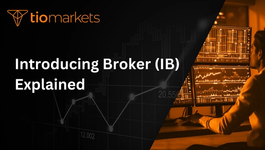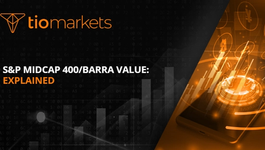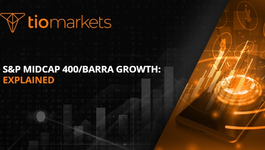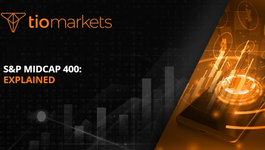S&P SmallCap 600: Explained
BY TIOmarkets
|August 15, 2024The S&P SmallCap 600 is a stock market index introduced by Standard & Poor's. It covers a broad range of small-cap companies in the United States, providing a comprehensive benchmark for investors interested in this segment of the market. This glossary entry will delve into the intricacies of the S&P SmallCap 600, its significance in trading, and how it is calculated.
Understanding the S&P SmallCap 600 is crucial for traders and investors who wish to diversify their portfolio and tap into the potential of small-cap companies. These companies, while often overlooked in favor of their larger counterparts, can offer significant growth potential and can be a valuable addition to a well-rounded investment strategy.
What is the S&P SmallCap 600?
The S&P SmallCap 600 is an index that tracks the performance of 600 small-cap companies in the United States. These companies are typically those with market capitalizations between $300 million and $2 billion. The index is designed to be representative of the small-cap segment of the U.S. equity market, providing a reliable benchmark for investors and traders.
The S&P SmallCap 600 is one of several indices introduced by Standard & Poor's, a division of S&P Global. Other indices include the S&P 500, which tracks large-cap companies, and the S&P MidCap 400, which focuses on mid-cap companies. Together, these indices provide a comprehensive overview of the U.S. equity market.
Why is the S&P SmallCap 600 important?
The S&P SmallCap 600 is important because it provides a benchmark for the performance of small-cap companies. By tracking the index, investors can gain insight into the health of the small-cap segment of the market, which can be a useful indicator of overall market conditions.
Furthermore, the S&P SmallCap 600 can be used as a tool for portfolio diversification. By investing in small-cap companies, investors can potentially achieve higher returns, although this comes with a higher level of risk compared to investing in large-cap companies.
How is the S&P SmallCap 600 calculated?
The S&P SmallCap 600 is calculated using a market capitalization-weighted methodology. This means that the larger a company's market capitalization, the greater its impact on the index. The index is calculated by summing the market capitalization of each company in the index and then dividing by a divisor. The divisor is a proprietary figure developed by Standard & Poor's and is adjusted to ensure that changes in the index reflect changes in the market capitalizations of the companies in the index, rather than changes in the composition of the index itself.
It's important to note that the S&P SmallCap 600 is a float-adjusted index. This means that only shares available for public trading are considered when calculating the index. Shares held by insiders or other entities that are not available for public trading are excluded from the calculation.
Trading the S&P SmallCap 600
Trading the S&P SmallCap 600 can be done in several ways. One of the most common methods is through exchange-traded funds (ETFs) that track the index. These ETFs aim to replicate the performance of the S&P SmallCap 600 by holding the same stocks in the same proportions as the index. By investing in an ETF, traders can gain exposure to the entire small-cap market segment without having to buy shares in each individual company.
Another method is through futures contracts. The Chicago Mercantile Exchange (CME) offers futures contracts on the S&P SmallCap 600, allowing traders to speculate on the future direction of the index. Futures trading can be complex and carries a high level of risk, so it's important for traders to fully understand the mechanics of futures trading before getting started.
Benefits of Trading the S&P SmallCap 600
Trading the S&P SmallCap 600 offers several benefits. First, it provides exposure to a diverse range of companies. This can help to spread risk and potentially increase returns. Second, small-cap companies often have greater growth potential than larger companies, which can lead to higher returns. However, this also comes with a higher level of risk.
Another benefit is the ease of trading. Through ETFs and futures contracts, traders can gain exposure to the entire index with a single transaction. This can be more efficient than buying shares in each individual company.
Risks of Trading the S&P SmallCap 600
While trading the S&P SmallCap 600 can offer potential benefits, it also comes with risks. Small-cap companies are often more volatile than larger companies, which can lead to larger price swings. This can increase the potential for losses.
Another risk is the lack of liquidity. Some small-cap stocks may not be as heavily traded as larger stocks, which can make it more difficult to buy or sell shares without impacting the price. This can be particularly problematic in volatile market conditions.
Conclusion
The S&P SmallCap 600 is a valuable tool for traders and investors interested in the small-cap segment of the U.S. equity market. It provides a benchmark for the performance of small-cap companies and can be used as a tool for portfolio diversification.
However, trading the S&P SmallCap 600 also comes with risks. Small-cap companies are often more volatile and less liquid than larger companies, which can increase the potential for losses. As with any investment, it's important to thoroughly research and understand the risks before getting started.
Start Trading SmallCap Stocks with TIOmarkets
Ready to dive into the dynamic world of small-cap stocks? Join TIOmarkets, a top-rated forex broker with a robust online trading platform. Trade over 300 instruments across 5 markets, including indices like the S&P SmallCap 600, with low fees. Benefit from our comprehensive suite of educational resources to sharpen your trading skills. With more than 170,000 accounts opened in over 170 countries, we're committed to helping you succeed. Create a Trading Account today and start your journey with TIOmarkets.

Risk disclaimer: CFDs are complex instruments and come with a high risk of losing money rapidly due to leverage. You should consider whether you understand how CFDs work and whether you can afford to take the high risk of losing your money. Never deposit more than you are prepared to lose. Professional client’s losses can exceed their deposit. Please see our risk warning policy and seek independent professional advice if you do not fully understand. This information is not directed or intended for distribution to or use by residents of certain countries/jurisdictions including, but not limited to, USA & OFAC. The Company holds the right to alter the aforementioned list of countries at its own discretion.
Join us on social media

Behind every blog post lies the combined experience of the people working at TIOmarkets. We are a team of dedicated industry professionals and financial markets enthusiasts committed to providing you with trading education and financial markets commentary. Our goal is to help empower you with the knowledge you need to trade in the markets effectively.





